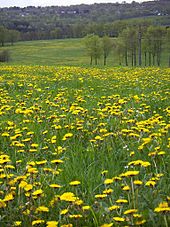Fettwiese
A fat meadow (also fat pasture or intensive grassland ) is a meadow rich in nutrients as a result of fertilization and seldom irrigation .
Like all Central European meadows, fat meadows are used areas that would develop into other ecosystems without agricultural use.
characterization
Traditionally, fat meadows were cut two or three times a year to make hay. Today, intensively used fat meadows are cut up to six times a year, the clippings are usually not dried as hay, but preserved in silage . The more intensive the use, the lower the biodiversity of a fat meadow. Traditionally used fat meadows are usually made up of around 30 types of plants, dry meadows in transition to poor meadows have up to 40 types. The "gold oat meadows" of the low mountain range are similarly rich in species with 30–40 species. In contrast, intensively used fat meadows show only 10–20 species. A uniform yellow or white color due to the massive occurrence of dandelions , sharp buttercups or tall, white-flowered umbelliferae such as penkolos and hogweed is characteristic of heavily fertilized meadows . Due to the high nitrogen content in the soil, the individual plants grow tall. Traditionally used, only moderately fertilized meadows, on the other hand, can be very blooming and colorful.
Types of fat meadows
The typical fat meadows are called in the plant-sociological system after the tall (upper) grass species smooth oat (Arrhenaterum elatius) smooth oat meadows (scientific name Arrhenateretum elatioris) (in Switzerland also Fromentalwiese). In the higher altitudes of the Alps and the low mountain ranges (from approx. 500 m altitude) they are replaced by the similar gold oat meadows (Association Polygono-Trisetion), named after the gold oat . Greasy meadows of heavily wet or springy valleys belong to the marsh marigold meadows (in the plant-sociological system the association Calthion palustris). Grazed stands of all moisture levels, d. H. Fat pastures differ from meadows in that the sward is much less high. They are summarized in the association Cynosurion cristati (named after the comb grass , Cynosurus cristatus). Stocks that are used intensively for agriculture can no longer be classified in this system due to their extreme species poverty. In extreme cases, it is grass fields established by sowing from only one type of grass, which can only be (sparsely) accompanied by arable weeds (transition to field grass cultures as arable land is fluid in practice).
Character types of the fatty meadows and pastures of the lower altitudes (Arrhenatherion): meadow chervil , common oatmeal , soft rock , caraway , meadow pippau , meadow crested grass , common ball grass , reed fescue , meadow fescue , white bedstraw , meadow hogweed , woolly hogweed Honeydew grass , field scabious , Italian ryegrass , German ryegrass , meadow timothy , large beaver , meadow bluegrass , common bluegrass , common buttercup , meadow sorrel , common dandelion , white clover , germander speedwell
The hands of semi-fat fresh meadows (Festuco-Agrostion): red ostrich grass , daisies , red fescue
Characteristic species of yellow oat meadows higher layers (Polygono-Trisetion): Alchemilla vulgaris , Astrantia major , Hairy Chervil , soft-haired Pippau , wood cranesbill , Myosotis sylvatica , Meisterwurz , Black Devil's Claw , Bistort , Vielblütiger grove buttercup , red campion , Trollblume
Ecology, site conditions
Due to the favorable moisture and nutrient conditions in the soil, mown meadows are mostly dense and tall. In crops that are less heavily fertilized, a multi-layer structure with " upper ", "middle" and " lower grasses " as well as herbs in different layers can be observed . Heavily fertilized stands consist almost entirely of upper grasses and are single-layered. Close to the ground it remains relatively moist and cool due to the dense growth.
Significance for species protection, threat
The less intensively used, more species-rich forms of the Fettwiesen were strongly pushed back and have become rare in many regions, especially in low elevations. A representative analysis in the federal state of North Rhine-Westphalia ("ecological sample area") showed, for example, that intensely fertilized grassland (meadows and pastures combined) now makes up 93% of the total grassland area of the state. 74% are species-poor and only 19% are species-rich meadows. (Grassland that does not belong to the fat meadows, i.e. wet meadows and poor meadows together, still make up 7%).
Switzerland has set up a national program to protect the most valuable and species-rich dry meadows and pastures . This was preceded by a national mapping of potentially suitable areas. "Dry, species-rich meadows and pastures (mapping group AE)" were also processed. The nature conservation value of these "semi-fat" meadows and pastures is classified as low compared to the real dry grassland, despite the mostly very species-rich stands. However, they are only a refuge for rare or endangered target species of the protection program in exceptional cases.
literature
- Raymond Delarze, Yves Gonseth, Pierre Galland: Swiss habitats. Ecology - endangerment - characteristics. 2nd Edition. 2008, ISBN 978-3-7225-0069-0 , chap. 4.5 Arrhenatheretalia
- Heinz Ellenberg : Vegetation of Central Europe with the Alps from an ecological, dynamic and historical perspective. 5th, heavily changed and improved edition. Ulmer, Stuttgart 1996, ISBN 3-8001-2696-6 , Arrhenatheretalia (5.42).
- Erich Oberdorfer (Ed.): South German Plant Societies. Part 2: Sand and dry grasslands, heather and bristle grass societies, alpine grasslands, fringing societies, field and tall forbidden corridors. G. Fischer, Jena et al. 1978, DNB 790038536 : Arrhenatheretalia
- Ladislav Mucina and others: The Austrian Plant Societies . G. Fischer, Jena et al. 1993: Arrhenatheretalia
- H. Dierschke (arr.): Molinio-Arrhenatheretea. Part 1: Arrhenatheretalia. (= Synopsis of the Plant Societies in Germany. Issue 3). 1997, DNB 958358818 .
Individual evidence
- ^ S. Eggenberg, T. Dalang, M. Dipner, C. Mayer: Mapping and assessment of dry meadows and pastures of national importance. Technical report. (= Environment series. No. 325). Federal Office for the Environment, Forests and Landscape , 2001.

